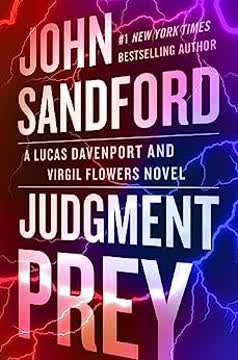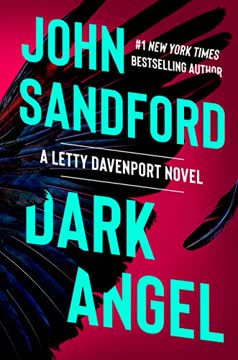Plot Summary
The Maddog's Lethal Obsession
The maddog, a meticulous and intelligent killer, thrives on the thrill of the hunt, targeting women to satisfy his twisted need for power and control. His latest victim, an artist, narrowly escapes, leaving him frustrated but undeterred. The maddog's history of violence is marked by meticulously planned and executed murders, each adhering to his self-imposed rules. His obsession with perfection and evasion of capture fuels his dark desires, as he prepares for his next move, determined to maintain his deadly game.
Lucas Davenport's Unyielding Pursuit
Lucas Davenport, a brilliant and unconventional detective, is tasked with capturing the maddog killer. Known for his unorthodox methods and sharp instincts, Davenport navigates the complexities of the case, piecing together clues and patterns. Despite the pressure from the media and the public, he remains focused on the hunt, determined to outsmart the killer. Davenport's personal life intertwines with his work, adding layers to his character as he balances the demands of the case with his own moral compass.
A Killer's Rules and Games
The maddog operates by a strict set of rules designed to keep him undetected. He never kills anyone he knows, avoids motives, and leaves no physical evidence. His fascination with games and strategy mirrors his approach to murder, viewing each kill as a move in a larger game against the police. The maddog's intelligence and planning make him a formidable adversary, as he continues to evade capture while taunting the authorities with his cryptic notes.
The Wrong Suspect's Ordeal
The police arrest Jimmy Smithe, a gay welfare worker, as the prime suspect in the maddog case. Despite the mounting evidence against him, Davenport doubts Smithe's guilt, believing the real killer is still at large. Smithe's life is turned upside down as he faces public scrutiny and the threat of imprisonment. Davenport's instincts lead him to question the evidence, pushing him to find the truth and prevent a miscarriage of justice.
A Dangerous Game of Deception
The maddog, angered by the police's mistake, contacts Davenport directly, revealing his knowledge of the investigation and taunting the detective with his continued freedom. This bold move confirms Davenport's suspicions about Smithe's innocence and reignites his determination to catch the real killer. The phone call serves as a turning point, intensifying the psychological battle between the detective and the maddog, as each tries to outwit the other.
The Maddog's Calculated Escape Plan
The maddog, aware of the police surveillance, devises a plan to slip away unnoticed. He exploits the layout of a law office building to evade his watchers, using an internal elevator to exit on a different floor. This clever ruse allows him to disappear for a crucial two hours, during which he prepares for his next move. The maddog's ability to outsmart the police highlights his intelligence and adaptability, setting the stage for a final confrontation.
Lucas Davenport's Desperate Pursuit
Lucas Davenport, realizing the maddog's escape, races against time to prevent another murder. He pieces together the killer's intentions, suspecting that Carla Ruiz is the next target. Davenport's urgency and determination drive him to push the limits, both physically and mentally, as he navigates the complexities of the case. His relentless pursuit underscores his commitment to justice and his personal connection to the victims.
A Deadly Game of Deception
The maddog uses deception to his advantage, creating a false sense of security for the police. He plants misleading evidence and exploits the weaknesses in the surveillance, all while planning his next attack. This chapter delves into the psychological warfare between the maddog and Davenport, as each tries to outwit the other. The tension builds as the killer's true intentions become clear, leading to a high-stakes showdown.
The Maddog's Final Stand
The maddog, cornered and desperate, makes a final stand against Davenport. The final confrontation is intense and brutal, with both men pushing their limits. The maddog's arrogance and overconfidence ultimately lead to his downfall, as Davenport's quick thinking and determination prevail. This climactic moment serves as a turning point, bringing the maddog's reign of terror to an end and highlighting the consequences of his actions.
The Maddog's Last Mistake
The maddog's overconfidence and miscalculations lead to his ultimate downfall. His inability to anticipate Davenport's moves and his underestimation of the detective's resolve prove to be his undoing. This chapter highlights the maddog's psychological unraveling, as his carefully constructed facade crumbles under pressure. The final confrontation serves as a cautionary tale about the dangers of hubris and the inevitability of justice.
Characters
Lucas Davenport
Lucas Davenport is a complex character, known for his intelligence and unorthodox methods. He is deeply committed to solving the maddog case, driven by a sense of justice and a personal connection to the victims. Davenport's ability to think like the killer makes him a formidable opponent, but his personal life and moral dilemmas add depth to his character, making him relatable and human.
The Maddog
The maddog is a chilling antagonist, driven by a need for power and control. His strict adherence to his own rules and his fascination with games make him a unique and terrifying figure. The maddog's intelligence and planning allow him to evade capture, while his taunting of the police adds a psychological dimension to his crimes. His character is a study in the dark side of human nature, exploring themes of obsession and madness.
Jimmy Smithe
Jimmy Smithe is a welfare worker wrongfully accused of being the maddog killer. His life is turned upside down as he faces public scrutiny and the threat of imprisonment. Smithe's character highlights the dangers of jumping to conclusions and the impact of false accusations. His ordeal adds tension to the narrative, as Davenport works to clear his name and find the real killer.
Carla Ruiz
Carla Ruiz is a key figure in the investigation, having survived an attack by the maddog. Her character adds a personal dimension to the case, as she grapples with fear and the aftermath of her encounter. Ruiz's relationship with Davenport provides insight into his character, as he balances his professional duties with personal connections.
Jennifer Carey
Jennifer Carey is a television reporter who becomes entangled in the maddog case. Her pursuit of the story and her relationship with Davenport add complexity to the narrative, highlighting the tension between the media and law enforcement. Carey's character explores themes of ambition and ethics, as she navigates the challenges of her profession.
Plot Devices
The Maddog's Rules
The maddog's rules are a central plot device, guiding his actions and keeping him undetected. These rules add a layer of complexity to the narrative, as Davenport works to understand and anticipate the killer's moves. The rules also serve as a psychological insight into the maddog's character, revealing his need for control and his strategic mindset.
The Phone Call
The maddog's call to Davenport is a pivotal moment in the story, confirming the detective's suspicions and reigniting his determination to catch the killer. This plot device heightens the tension between the two characters, as the maddog taunts Davenport with his continued freedom. The phone call serves as a catalyst for the unfolding events, driving the narrative forward.
The Wrongful Arrest
The arrest of Jimmy Smithe is a significant plot device, highlighting the dangers of jumping to conclusions and the impact of false accusations. This event adds tension to the narrative, as Davenport works to clear Smithe's name and find the real killer. The wrongful arrest also serves as a commentary on the justice system, exploring themes of truth and justice.
The Final Confrontation
The final confrontation between Davenport and the maddog is a pivotal moment in the story, serving as the culmination of their psychological battle. This plot device heightens the tension and stakes, as both characters push their limits in a fight for survival. The confrontation ultimately leads to the maddog's downfall, bringing the narrative to a satisfying conclusion.
Analysis
"Rules of Prey" by John Sandford delves into the psychological complexities of both hunter and hunted, exploring themes of justice, obsession, and the human psyche's darker corners. Through the cat-and-mouse game between Lucas Davenport and the maddog, the narrative examines the fine line between order and chaos, and the lengths to which individuals will go to achieve their goals. The book serves as a commentary on the nature of evil and the relentless pursuit of justice, highlighting the moral dilemmas faced by those who stand against darkness. Sandford's storytelling captivates with its intricate plot and deep character studies, offering readers a thrilling and thought-provoking journey.
Last updated:
Review Summary
Rules of Prey introduces Lucas Davenport, a wealthy, womanizing detective hunting a serial killer in Minneapolis. Readers appreciate Sandford's engaging writing style, complex characters, and thrilling plot, though some find Davenport's behavior problematic. The book's 1980s setting feels dated to some, but many enjoy the nostalgic elements. While the serial killer trope is common, Sandford's execution keeps readers engaged. The series' long-running success is evident, with fans eager to continue following Davenport's cases despite mixed feelings about his character.
Lucas Davenport Series
Similar Books
Download PDF
Download EPUB
.epub digital book format is ideal for reading ebooks on phones, tablets, and e-readers.


















